by Tom Gaylord
Writing as B.B. Pelletier
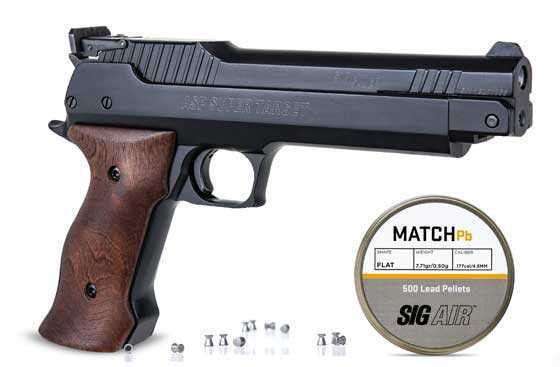
Sig Air Super Target (photo provided courtesy Sig Sauer).
This report covers:
- Storage
- The latch for the top strap
- Valve and hammer
- Dry-firing
- Velocity — Sig Match Pb pellets
- Sig Match Pb
- Cocking and pumping behavior
- RWS Hobby
- Sig Match Ballistic Alloy
- Can it go faster?
- The breech
- Pumping effort
- Trigger pull
- Summary
Today we test the velocity of the new Sig Super Target single stroke pneumatic (SSP) target pistol, plus I have a number of additional things to address. Let’s get started!
Storage
First, let’s talk about storage. In the owner’s manual Sig tells you to do two things that I been doing for SSPs and recommending for many years. Number one, they tell you to store the pistol with the barrel (top strap) broken open. They don’t say it but I think this is to relieve pressure on the o-ring that seals the breech. Number two, they tell you that if the pistol has not been used in a while to pump and dry-fire the pistol 3-5 times to ensure the elasticity of the piston seals. I have been doing this for several years and most recently I told you about it in the tests of the IZH MP532 target air rifle. I even gave you a procedure for getting an SSP ready to fire if it had older seals that may have become hardened with age. Today I am going to test that and also answer a couple questions that reader Lian asked me last week.
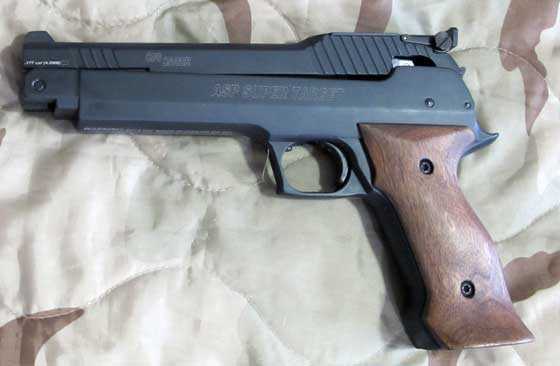
Sig recommends storing the Super Target broken open like this.
The latch for the top strap
Reader Lain asked me about the hammer that I said is used to latch the top strap. He couldn’t see one like that on the FAS 6004, which he believes is the basis for the Super Target. So I photographed this one for him.
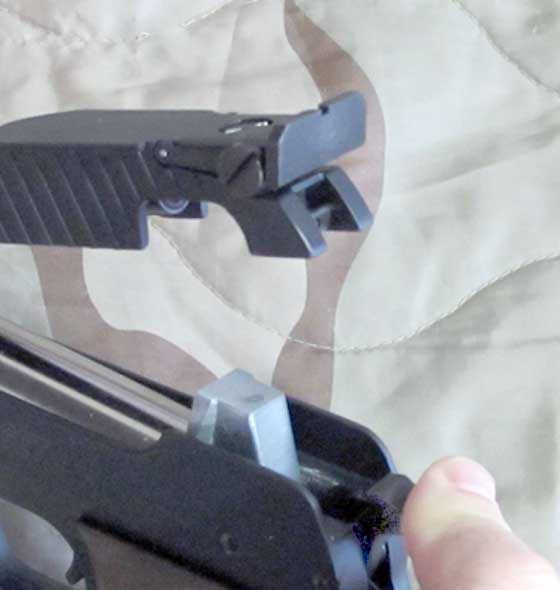
Here you see the bar across the top strap that the hammer latch slips over to keep the top strap secure. In this photo it’s hard to see the notch in the hammer that latches over the bar.
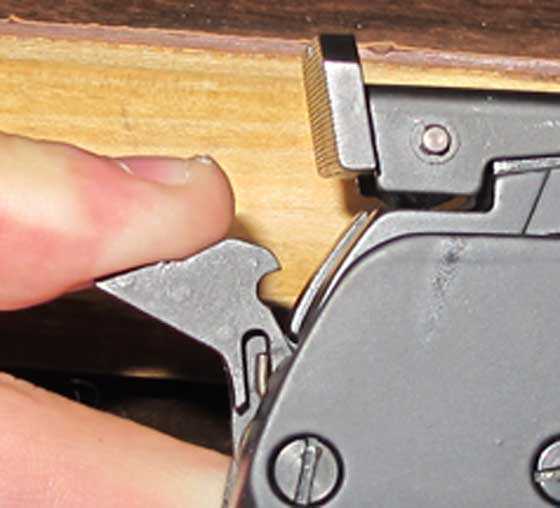
Here is the hammer pulled back. You can see the cutout for the bar in the top strap.
Valve and hammer
Several readers asked about the valve — is it like the valve on a Beeman P17. No, it is not. The Super Target valve is a dump valve. That is a type of valve that, when the hammer hits the valve stem, it remains open so all the air can exhaust. That raises a second question. Can the Super Target be cocked and dry-fired without pressurizing it?
Dry-firing
I will say this — it is possible to cock the gun without pressurizing it by lifting the top strap up almost vertical until you hear a click. It is then possible to dry-fire the pistol. I asked Sig whether dry-firing is okay and they didn’t see that it was a problem. The hammer strikes the valve stem of the Super Target pretty hard when you dry-fire and I don’t think I’m going to do it as a matter of course, though I don’t suppose a few shots now and then can do any harm.
A competition 10-meter target shooter shoots 5 times as many shots dry as he does with pellets and I don’t think the Super Target was designed with that in mind. Then again, this is not a formal competition 10-meter pistol. It’s for informal matches and practice.
Velocity — Sig Match Pb pellets
Sig rates the Super Target at up to 400 f.p.s. I assume that is with lightweight lead-free pellets. They recommend Sig Match Lead pellets for the pistol, so let’s start with them. Before I began shooting I dry-fired the pistol (with air) 5 times, per the manual.
Sig Match Pb
Ten Sig Match Pb pellets that weigh a uniform 8.2 grains averaged 328 f.p.s. from the Super Target. That’s pretty good for a heavier lead pellet. The spread went from a low of 325 to a high of 335 f.p.s., so a spread of 10 f.p.s. That’s pretty consistent.
Cocking and pumping behavior
I must say this pistol cocks with absolutely no noise that I can hear. It is extremely smooth. And the pumping never gets too hard. I will test it in a bit, but I think it’s lighter than the Beeman P3 or P17. I no longer own a Daisy 777 or 717, but this pistol feels as light to pump as I remember them being, and they are the lightest SSP pistols I have ever seen. If the pumping effort has kept you from an SSP pistol, this may be a good one for you. At least put it on your short list to try.
RWS Hobby
The next pellet I tested was the 7 grain RWS Hobby. Their light weight makes these wadcutters the speed demons of the lead pellet world. Ten of them averaged 338 f.p.s. in the Super Target. The spread went from 333 top 343 f.p.s., so again a 10 f.p.s. spread. Very consistent.
Sig Match Ballistic Alloy
If any pellet is going to go 400 f.p.s. it will be one like the 5.25-grain Sig Match Ballistic Alloy target pellet. When I tested them 10 averaged 385 f.p.s. with a spread that ranged from 380 to 390 f.p.s. A third 10 f.p.s. spread! We are beginning to see great consistency!
H&N Finale Match Light
The last pellet I tested was the H&N Finale Match Light wadcutter. These weigh 7.87-grains so I expected them to be a little slower than the Hobbys, but 10 averaged 337 f.p.s. That 9 f.p.s. faster than the Hobbys! The spread went from 333 to 343 f.p.s. so — you guessed it — 10 f.p.s.
Can it go faster?
Okay, this is also for Lian. I had planned last week to do this in today’s report and held off discussing it because I wanted everyone to know the answer at the same time. Lian asked me if pumping partial strokes the way I told you for the IZH MP532 rifle would also work on this pistol. The 532 and IZH 46 pistol have a solid pump cup on the end of their pistons. Lian suspects that the Super Target has an o-ring on the side of the piston to seal, because the FAS 6004 pistol on which it is based has one. That’s like the pistons of the P17 and P3 that we have seen and worked on.
I wasn’t sure how this pistol would react, so I decided to test it. I pumped the pistol partially 20 times to work and soften the o-ring It may not be a pump cup but it is a synthetic seal and working it should make it more flexible. And sealing the piston should work regardless of how it is done.
Then I shot 10 Sig Match Ballistic Alloy pellets for speed. Before each shot I pumped the pistol partially once before pumping it all the way. Here are the results.
Shot……….Velocity
1.……………..406
2.……………..408
3.……………..412
4.……………..408
5.……………..405
6.……………..404
7….…………..404
8….…………..408
9.……………..408
10…………….413
There you have it. The average for this string is 408 f.p.s., which is 23 f.p.s. faster than the previous average of 385 f.p.s. when I didn’t do partial pumps. Lian, that is the answer. Yes, o-rings respond to partial pumps in the same way that pump cups do. And everyone else — yes, the Super Target pistol is a 400 f.p.s. air pistol. And the spread for this string is just 9 f.p.s. — 404 to 413 f.p.s. So BBs shenanigans don’t disrupt the Super Target’s stability.
The breech
I researched the FAS 6004 pistol because Lain had referred to it and I found a problem with some of their breeches. Apparently they have a chamfer in the breech that is sometimes not cut smoothly. So I examined the breech of the Super Target I’m testing and found it had a chamfer that’s as smooth as glass. That’s what I expected from Sig Air and little details like this are what take so much time to iron out before airguns make it to the market
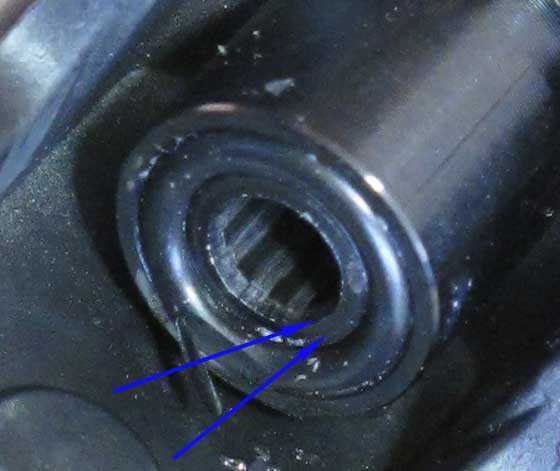
The breech chamfer is between the points of the two blue arrows. It is so smooth that you can see no detail! Yes, the rifling is also cut in a leade (a tapered lead-in to not damage the pellet so much when it loaded), but that’s not what I’m referring to here.
Pumping effort
I measured the effort to pump the pistol at 18 lbs. on my scale. As a comparison, the Beeman P17 needed 35 pounds to pump, so this pistol only needs 1/2-pound more than half the effort to pump as the P17. That is what I was talking about when I said it is easy!
Trigger pull
This report is getting long. I wanted to adjust the trigger for you today, but I’m not going to rush it. I will just measure the trigger pull as it came to me in this report and give it a longer writeup next time.
Stage one took one pound to complete. Stage two broke at exactly 2 pounds. Next time I will adjust it.
Summary
So far, so good. No, strike that. So far — excellent! I hope this Super Target is as accurate as it is nice in all the other important categories. Because I don’t think I’m sending this one back. A guy can’t have too many accurate air pistols!

Sounds like Pistol week at BB’s blog!
-Y
Yogi,
Yes it is! 😉
B.B.
Yogi,
Just what I was thinking!
Oops! Wrong one.
Yogi,
Just what I was thinking!
BB,
If you pull a FAS 6004 out to test this week I will simply lose it.
You did not mention yesterday about leaving the breech unlatched on the 46M when not shooting. This is something I always do. The Webley Senior and the Service MK II are unlatched also.
RR,
No FAS 6004 in the immediate future, so you’re safe.
I didn’t address the breech on the 46M because I haven’t gotten to that part yet. It will be in the next report, where I hope to show something dramatic.
B.B.
B.B. Too bad you aren’t doing a FAS 6004 blog – would have been entertaining to see RR ricocheting of the walls LOL!
Hank,
Fortunately for me PA does not sell those. They come from that other airgun dealer.
RR
I’m glad you mentioned that. I was going to say something in the past but it just slides on by for some reason.
When I’m done shooting my Bolt action air guns I lift the bolt handle and pull back till the o-ring is not engaged anymore be it in the barrel or on the probe. And note I don’t cock the gun. I just pull back to touch the spot before it starts pulling back to cock the striker.
A few examples are 1322/77’s, Marauder’s, Discover’s, Maximus, Gauntlets and so on.
Basically what I’m trying to avoid is the o-ring being compressed. What I explained will help the probe seal good all the time. No leakage is what it boils down to to.
Gunfun1,
Exactly!
The fact that DAQ chose to go “old school” and have a cocking lever separate from the bolt on his guns helps with that as well as being able to show the bolt back to RSOs (Range Safety Officers) without having to decock.
shootski
Shootski
I don’t have a DAQ and haven’t looked at them. But I’m thinking the guns I mentioned the bolts don’t open up enough for the he Range Officers.
My main concern is to not prematurely wear (or form) the o-ring so it won’t seal the bolt to the barrel. Seen problems with that even when I was young shoot’n air guns.
GF1,
I have found many old air rifle seals that were flat as pancakes for being compressed for many years.
RR
It don’t take long for them to take a shape.
You should see some of the air and hydraulic cylinder o-rings I find when rebuilding stuff at work. They actually start taking a square shape. And that’s definitely not a good thing when making a seal.
From what I have seen over the years there is really no way to avoid it. But I do think leaving the bolt open on a air gun breach is a good thing. Heck it might even help a break barrel breech seal to store the gun with the barrel broke but not cocked.
Probably the worst that can happen is a spider or bug gets in the barrel or transfer port opening. But I would bet we wouldn’t even know the difference. We would just shoot it right on out on the first shot.
I haven’t stored my break barrel’s that way but maybe I will start. Maybe even a underlever?
GF1,
It is of great benefit to break barrels, especially if they are machined tight. So you might get a bug splatter on the feral soda can.
RR
Right. A new kind of splatter target. 😉
GF1,
My wife would like to see a bunch of spider splatters.
GF1,
Excellent suggestion on leaving the bolt slightly open so it doesn’t compress the O-ring. I never even considered that, but it makes perfect sense. Now I am wondering if I should also slightly open the breech on my RWS 34? I will certainly take the pressure off my Urban’s bolt, and my Crosman 147 multi-pump’s bolt too.
Geo
Geo
Exactly. I think it would be beneficial as long as you could store the gun so it don’t fall or something.
B.B.
Adding a breech chamfer to the Beeman P17 is a quick mod that makes loading the pellets so much easier – something that owner should do.
In the picture you showed of the breech chamfer, I noticed that the breech seal is damaged. Don’t know if it is enough to affect the velocity tests but you might want to check it.
Winter is early this year, our second snowfall dumped over a foot of the “pretty white stuff” …glad that I have a good snowblower! Between the snow and the deer hunting season being open we have over a dozen deer hanging out close to the house where they know it’s safe.
Hank
Hank,
Good eye! I took the picture, Photoshopped it for the blog and never noticed that.
I recently bought a selection of different metric (and US) o-rings, so I will change that for the next test and also test the velocity with at least one pellet again — to see if that changes anything. That tear is very small and the o-ring seal is under compression when the barrel is closed, so there may not be a problem.
But thanks!
B.B.
B.B.
I have those O-ring kits as well – very convenient and a lot more economical than buying the O-rings by the each 🙂
When I see O-ring damage like that (looks like it has been “sliced”) I go looking for a burr or sharp edge to fix.
Cheers!
Hank
Hank,
Yes, I will be checking for a burr. That slice is actually at the top of the ring, but the picture is upside-down. That’s why it wasn’t evident before. I have to light it and use a loupe to see it now– even when I know where to look.
B.B.
B.B.,
I was on the SIG page looking at the pictures and getting a picture in my mindseye of how the barrel and the TP geometry lock up. The picture on the SIG page shows what looks like a U Strap and two bolts/screws holding the rear of the barrel to the top inside of the slide. Does that look like how the barrel could be swapped in/out to you? The cut location on the O-ring makes even less sense now! Unless your barrel is somehow not all the way forward in the slide.
shootski
shootski,
I think the TINY tear is a random thing. I have checked everything that could do it and there is nothing. Fortunately, Sig packed a spare o-ring with the pistol.
B.B.
B.B and Hank,
Oops! Teaches me to keep reading a few more posts down!
shootski
Vana2,
Good catch! It looks like a piece of the O-Ring was still hanging on at the time of the photograph.
What I find most interesting is the position and fact that it looks like a cut.
B.B. needs to do some checking on what might have done that; IF in fact it is a cut.
shootski
Hank,
Good catch!!!!! Quite obvious in the picture. (I did not see it,… but then again my AM reading time is quite limited, despite getting up early). You lucky retired guys have all the time in the world to catch all that micro detail “stuff”! 😉
Chris
A little off subject but been meaning to bring this up.
I got that Bear River MX1000 a few weeks ago. And I have to say it really is very accurate despite the double action trigger. It’s making good power with it’s very favorite 9 grain Winchester round nose pellets too. It’s about like shooting a .177 Discovery noise, power and accuracy wise.
But want I wanted to bring up it has a crown on the muzzle that is different than what I’m use to. The crown is about a mm long with probably a 15° angle. Don’t know why that would matter other than it helps eliminate a burr on the rifling when machining the crown. If so I do know burr free is the ticket on the breech and muzzle end.
There’s no markings where this gun is made at. But it makes me feel it’s a Japanese made gun by the way it’s constructed. Maybe it’s China made. But it’s different. And I should note though. A very solid gun for a full synthetic outside of the gun. Yes it’s like a air soft gun construction.
Gun fun,
Have you had any problems with the 88 gram cartridges leaking? There’s a lot of complaints on Amazon about that. Do you have some more specifics about power and accuracy?
Brent
Brent
I converted mine right away to a regulated 13 cubic inch HPA (high pressure air) bottle.
I will post a picture tomorrow of how I got it set up now. I changed a hose from the way I originally had it.
Power wise it will go through both sides of a tin can (not aluminum) at 50 yards. And it’s holding right at 1 inch at 50 yards now bench resting it. And I done those groups with the open sights and a scope. And that’s with the Winchester .177 caliber dome pellets.
Oh and as far as leaks go I haven’t had any on the HPA setup and never even tryed the 88 gram cartridge. So don’t know about that.
Brent
Here is a few pictures of what I used and with the old hose and new hose as the gun is now.
Old coiled long hose.
The way it is set up now with short hose.
Hey, B.B,, how would you say it compares to a Gamo Compact?
CSD,
The Gamo Compact has a more target-like grip because it is rougher and has a palm shelf. It cocks harder than the Sig.The Sig trigger is much better
I guess it all hinges on accuracy.
B.B.
I have the precursor to the Gamo Compact. I have the Gamo P-45 that AV, a.k.a. PA, down I-80/90 to the east of me here in Sandusky recently rebuilt because I flat out wore out the seals.
‘I will attest that the P-45 requires a determined push to close the over-lever/barrel to closure. I’ve done it thousands and thousands of times. One also learns that the closing hand on the top of the over-lever must assume a “feeding the horse a sugar cube” posture, i.e., flat and outstretched. That prevents a recurrence of the painful blood blister pinch that comes when closing it carelessly.
I have never measured the closing force, but it ramps up quickly. I suspect that the several single-pump pneumatic pistols that have over-levers all have that same need for the flat hand.
It would be interesting to do a quick comparison of the closing force required for the P-45, the Weirauch pneumatic version of the P-1 and both the Chiappa and the Sig Sauer units.
Lance
Lance,
I use the same hand when closing my Weihrauch HW75, although I also have extremely short fingers, so it’s not like other grips are an option.
I had the same blood blister pinch when handling a deactivated Beretta 96. My grip slipped when racking the slide and the giant ejection ports that Beretta likes so much got the meaty part of my palm.
The HW75 does require the most force in the last inch or two of travel when closing the action.
Nathan
For those of you who may be curious about the FAS 6004, here you go.
/airgun-experience/category/chiappa/
B.B.,
If you “buy into it”,… that tip on keeping the breech seal uncompressed might be a good regular addition to the everyday advice that you so often give. It makes sense to me. I can see storage and propping issues arising,… but still……….. A side lever stored in a case for storage might pose an issue (like the Red Wolf)? Still,… worthy of consideration I think. At the least,… breech seal replacement frequency would be lessened/required less often.
Chris
EDIT: In fact,… 3 minutes-ish after hitting “post”,… I opened the bolts on all 3 of my air rifles to destress/relax the breech seals. The RW now has the case open, bolt open,.. and a towel covering the rifle. A cut out in the foam and a block open pad may allow a cased closed storage situation?,… but for now this will work.
Chris USA,
You store that beauty in a case!
You need a proper wooden gun cabinet with glass windows, full spectrum lighting, climate control, and alarm system! Unless you go for a walk-in alarmed/vault door gun room with royal blue felt padded gun racks, cabinet grade wooden workbench, Gerstner tool/parts cabinets and upholstered seating… ;^)
shootski
Shootski,
((Leather)) “upholstered seating”. Italian. Burgundy colored. I am not completely uncivilized after all! LOL! 😉
It does get put on display on the weekends/days off,… which have been pretty short/rare as of late.
Good Day,…….. Chris
Is this pistol made in the USA ? If so, I will buy one.
Greg,
This pistol is made in Italy.
B.B.
Thank You